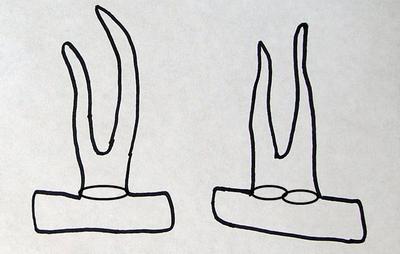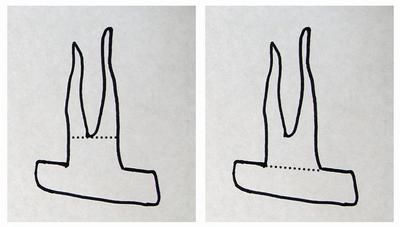Hunters that commonly score white-tailed deer antlers are familiar with the measurements necessary to score most sets of antlers. However, there are special circumstances that scorers will encounter that can make life difficult, particularly when scoring non-typical sets of antlers. One point of confusion with many new Boone and Crockett scorers occurs when they encounter common base points.
Although these types of points can occur on both typical and non-typical sets of antlers, common base points are not always abnormal. Ensure that you accurately measure your buck’s antlers by learning a little more about measuring common base points on antlers. It could make a big difference for you or someone you know!
First, common base points are points that are joined at their bases and share some degree of webbing between them. In the above photo, the drawing on the left (L) illustrates two points that do not have a common base. However, the figure on the right (R) depicts two points that do have a common base. The two points on the right are common base points. The easiest way to distinguish common base points from two points that do not share a common base is to perform an imaginary cross-section at the base of the points where they attach to the main beam.
In the above photo, the cross-section of the base on L looks like an oval, whereas the cross-section of the base on R looks like a peanut or a figure eight. This cross-sectioning process is critical in making the call and establishes that two distinct points do exist. The two points on R are common base points that both extend to the main beam, but they do share some degree of webbing. The two points on L consists of one normal point and one abnormal point.
Now that we established that the points on R are common base points, how do we measure them? Well, it depends on whether the points are matched or unmatched and whether they are normal or abnormal points. This sounds confusing, but lets work through it. Let’s say the points of R are located on the right antler and are the G2 and G3. If the G2 and G3 are also common base points on the left antler, then the points are considered matched because they are in the same place on each side of the antlers. In this case, all points are considered normal, but the points should be measured from the tips to the dashed line as illustrated in the figure on the left below. Measurements are taken this way on matched common base points because an inflated circumference measurement (H3 in this example) will be recorded between the G2s and G3s on both sides.
On the other hand, if common base points are found only on one side (either the left or right side of the antlers; unmatched), then one of the points is likely normal and the other is abnormal because the point spacing is interrupted. Regardless of whether or not one of the points is matched or unmatched, the points should be measured and scored from the tip of the points to an imaginary line along the top of the main beam (as illustrated in the above photo on the right side).



